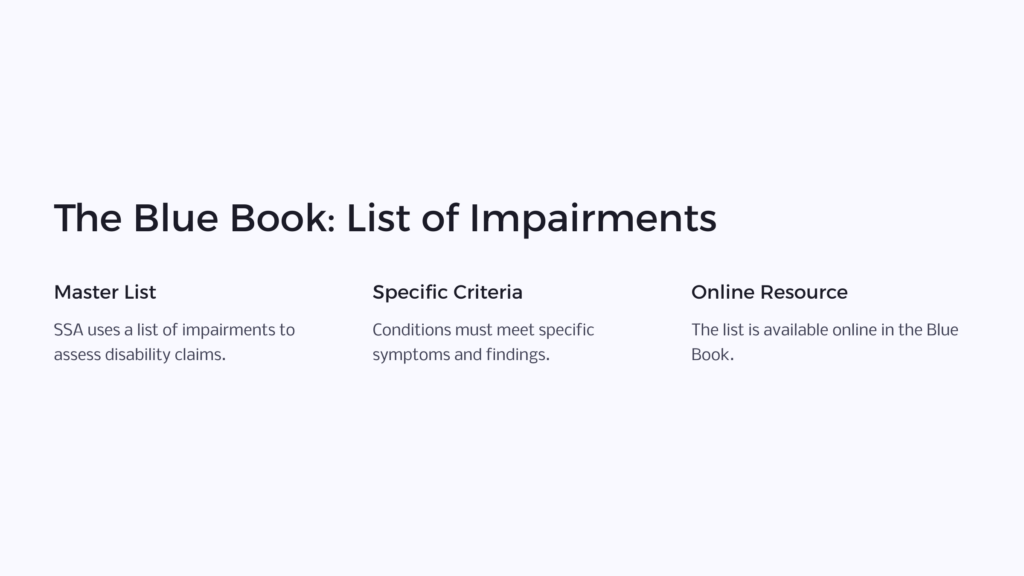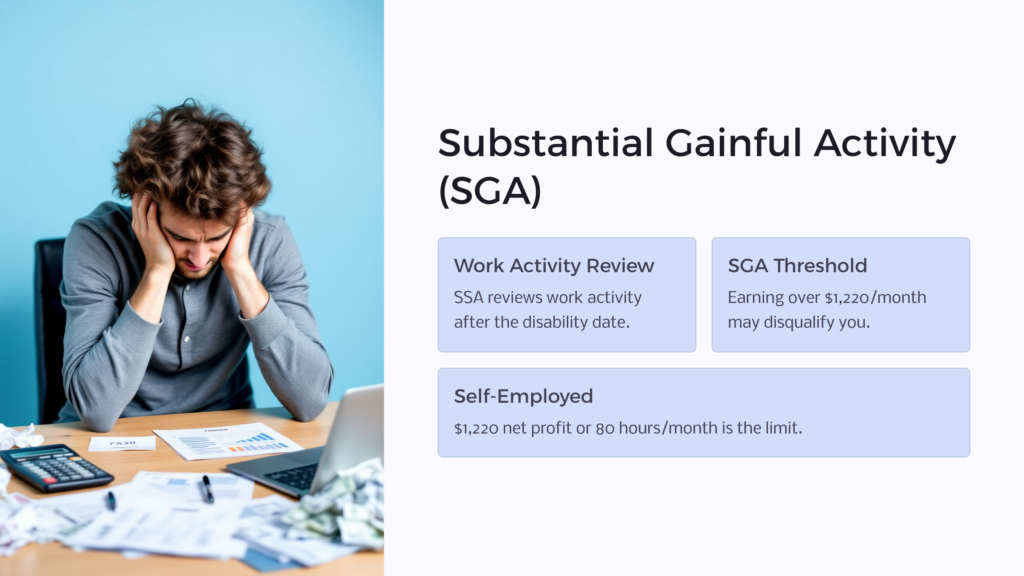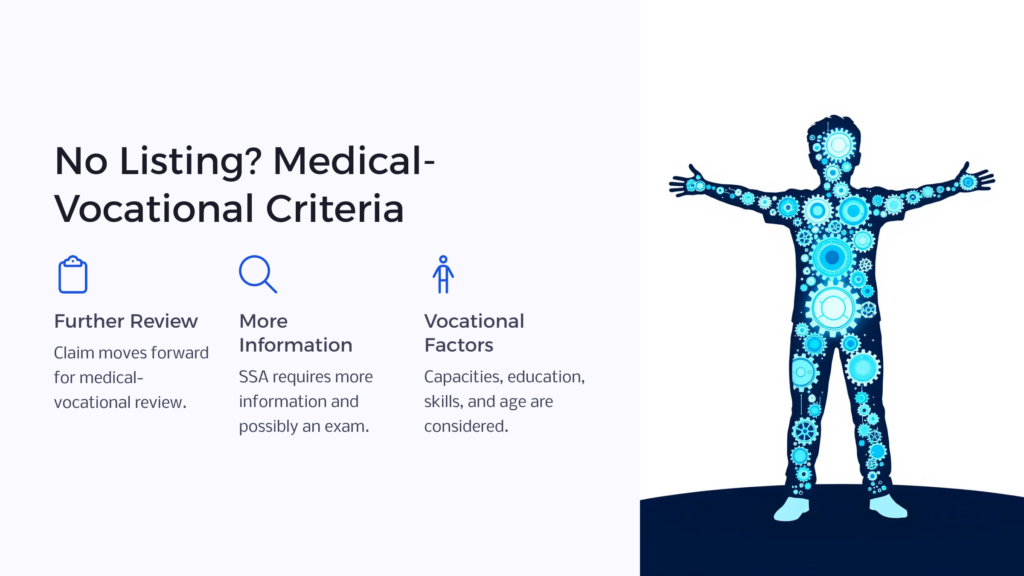In order to facilitate processing Social Security Disability and Supplemental Security Income claims for people with very severe illnesses or injuries, SSA has compiled a master list of impairments (limitations resulting from common serious diseases and injuries) that have been identified as likely indicators of disability.

If your condition meets the listings, your claim will be approved. The list is used by SSA’s claims examiners in the first medical step of the disability evaluation. This list is found in a manual titled Disability Evaluation under Social Security, known casually as “The Blue Book,” which through 2008 was a printed pamphlet and is now online).
Within this handbook is the List of Impairments organized by body systems. The diseases and limitations are broken down into specific signs and symptoms that indicate the existence of those conditions and under what circumstances the conditions are severe enough to warrant disability payments.
it is important to know that having your diagnosis listed does not provide instant approval of your case. We’ll explain how SSA applies the list when deciding your case and how you can help them make a quick evaluation and speed payments if you qualify.

The list of illnesses and injuries include those that are considered disabling but only apply if they are accompanied by certain symptoms, clinical findings, or test results. Having a certain diagnosis is not enough for your claim to be automatically approved; but if you have one of the conditions on the Social Security List of Impairments and you also have the symptoms and signs that are listed and provide proof of those symptoms and signs, then your condition will be considered disabling without further investigation.
Here’s an example from the listings: For a person’s medical condition to meet the musculoskeletal listings the following signs and symptoms are needed: the person has to be unable to walk effectively on a sustained basis or be unable to perform fine and gross movements with the upper body on a sustained basis, and the inability has to have lasted or be expected to last for at least twelve months.
Although the Disability Evaluation under Social Security lists many impairments, it certainly does not have all the diseases and injuries that could afflict everyone. SSA continues to update the list each year as new information and treatments become available. Also, if you have a diagnosis with a level of impairment that is equal to one of the Listings, you might be approved on that basis without consideration of your work history or education.
Before the Listings

Before your illness or injury is compared to the Listings, your work activity after the disability date you are claiming will be reviewed to determine whether it exceeds the amount of work you can do and still be considered disabled. According to SSA rules, disability for an adult is when a person has a medically verifiable impairment preventing them from performing substantial gainful activity (SGA). For wage earners in 2019, earning $1,220 gross wages is usually considered SGA.
For a self-employed individuals, the threshold is $1,220 net profit or eighty hours of work per month. How essential the services are to the business is also considered. If the worker has impairment-related work expenses, such as a back-brace or medication for their disabling condition, those expenses can be used to reduce earnings before SGA is evaluated. If you are not performing SGA, then your claim will be evaluated under the Listings. I the wage earner is blind, the threshold level of earnings is $2,040 gross wages or net self-employment profit.
Qualifying for Disability When Your Illness is Not in the Listings

If the condition for which you are claiming disability is not one of those in the Listings or is not accompanied by the required signs or test results, you could still qualify for benefits. Your claim will move forward for review and evaluation under medical-vocational criteria. SSA will just require more information from you and perhaps an examination by a consulting physician of their choice. When you do not meet the listed requirements, your limitations will be evaluated to determine whether you can do occupations you have done in the past and, if not, whether you can perform a new occupation. Your current capacities, education, training, and work skills will be considered in determining whether you can work in an occupation that is new to you. If you are age fifty or older, your age is also taken into consideration.
It is possible you may suffer from more than one impairment and that each on its own would not qualify for disability. However, when combined, SSA may find that your total limitations rise to the level of disability. For example, if you suffer from arthritis and a kidney problem, when considered together SSA may grant approval for a claim where separately they would not.
Proving Your Case Based on the Listings
To ensure a successful claim, especially based on the Listings, it is your responsibility to present medically acceptable evidence. You can just provide contact information for your medical providers for SSA to request the records, but if you want to be sure Social Security gets those records, it is best to either submit them or follow-up with your doctors’ offices to see whether they have been requested and sent. Evidence is principally tests and examinations that support the diagnosis and the findings enumerated in the Listings.
You need to make certain your medical records are complete and detailed because SSA will consider this of prime importance. Your doctors are the best authority on your status. Hopefully they have kept detailed chart notes. Because physicians are thinking about your care, not a disability claim, when they chart sometimes the records are not as complete as they could be and don’t have all the details needed by SSA to evaluate your case. The information needed would include all your visits to the doctor, the treatment plan, your body’s response to the treatment(s), any imaging tests, and all laboratory test results. Since this is so important, it is essential your records show you have reliably continued with a treatment plan without any unexplained lapses, such as missing appointments, skipping any treatment sessions or not taking the prescribed medication.
A Personal Journal
To round out your medical records, it can be helpful to keep a daily journal. In this record, you would note any symptom flares; any side effects of your prescription medication; your inability to perform any daily living tasks; you are employed, any limitations you had in being able to perform your work duties. Submitting a copy of this journal could help support your claim and corroborate what is in your medical records. Of course, most people don’t keep a journal, so you could write up a concise outline of the chronology of your illness or injury, symptoms, treatment, and response to treatment with at least approximate dates..
A Consulting Physician
If the medical records you submit are insufficient, SSA may hire a licensed consulting physician or medical professional as a consultant. This is not the preferred route to go. Your own physician will have a much better knowledge of your particular case because they have been following your progress for a much longer time. A one-time examination by another doctor who is only looking to verify or deny your condition exists will not provide the in-depth knowledge your own doctor could provide. If possible, have your doctor be very thorough and fill in any gaps in the medical records by providing supplementary notes, additional examinations, or more tests.
If you must attend a consultative examination, your chances of receiving an appropriate evaluation will be less and you claim will take longer to reach a decision. This is because such a doctor will be examining your case as an outsider and will not be familiar with the finer details of your situation like your family physician or specialist would be. Your regular doctor will know and understand your particular limitations because they will have been following the progress for a much longer time. Even though SSA doctor will access all the notes, treatments and tests concerning your case, they will lack the personal insight that only a family doctor would have. Beginning in March 2017, however, your doctors’ opinions will not be given heavier weight than other evidence, so it will be very important for any supportive letters from your physicians include the clinical basis for the doctor’s statement of your limitations.
Filing a Social Security Disability or Supplemental Security Income Claim
The first step in filing a disability claim if you are filing an adult claim is to start a claim online at www.ssa.gov or to visit a Social Security office or to call SSA at 1-800-772-1213 to request an in-person or telephone application interview with a claims representative in a local office. These field offices are located across the country. (Supplemental Security Income claims for children and for Social Security Childhood Disability Benefits must be completed by phone or in an SSA office.)
The field office is responsible for confirming all non-medical information. This would include your name, date of birth, employment, family status, citizenship, insured status for Social Security Disability, and income and assets for Supplemental Security Income. Then, your claim is sent to a contracted state agency called Disability Determination Services (DDS) for medical or medical/vocational evaluation as described above.
If Your Claim is Denied
All hope is not lost if your claim application is turned down. If you disagree with the reasons your claim was denied, you will have sixty days to appeal. If you are denied twice, you will be able to present your claim to an administrative law judge. Because these medical conditions can be complex, there may be room to argue an alternative interpretation of the facts, present additional evidence in your favor, or call on an expert witness. However, to follow this path, you will probably need the assistance of an attorney who has experience in Social Security Disability claims.
 Benefits.com Advisors
Benefits.com Advisors
With expertise spanning local, state, and federal benefit programs, our team is dedicated to guiding individuals towards the perfect program tailored to their unique circumstances.
Rise to the top with Peak Benefits!
Join our Peak Benefits Newsletter for the latest news, resources, and offers on all things government benefits.



















